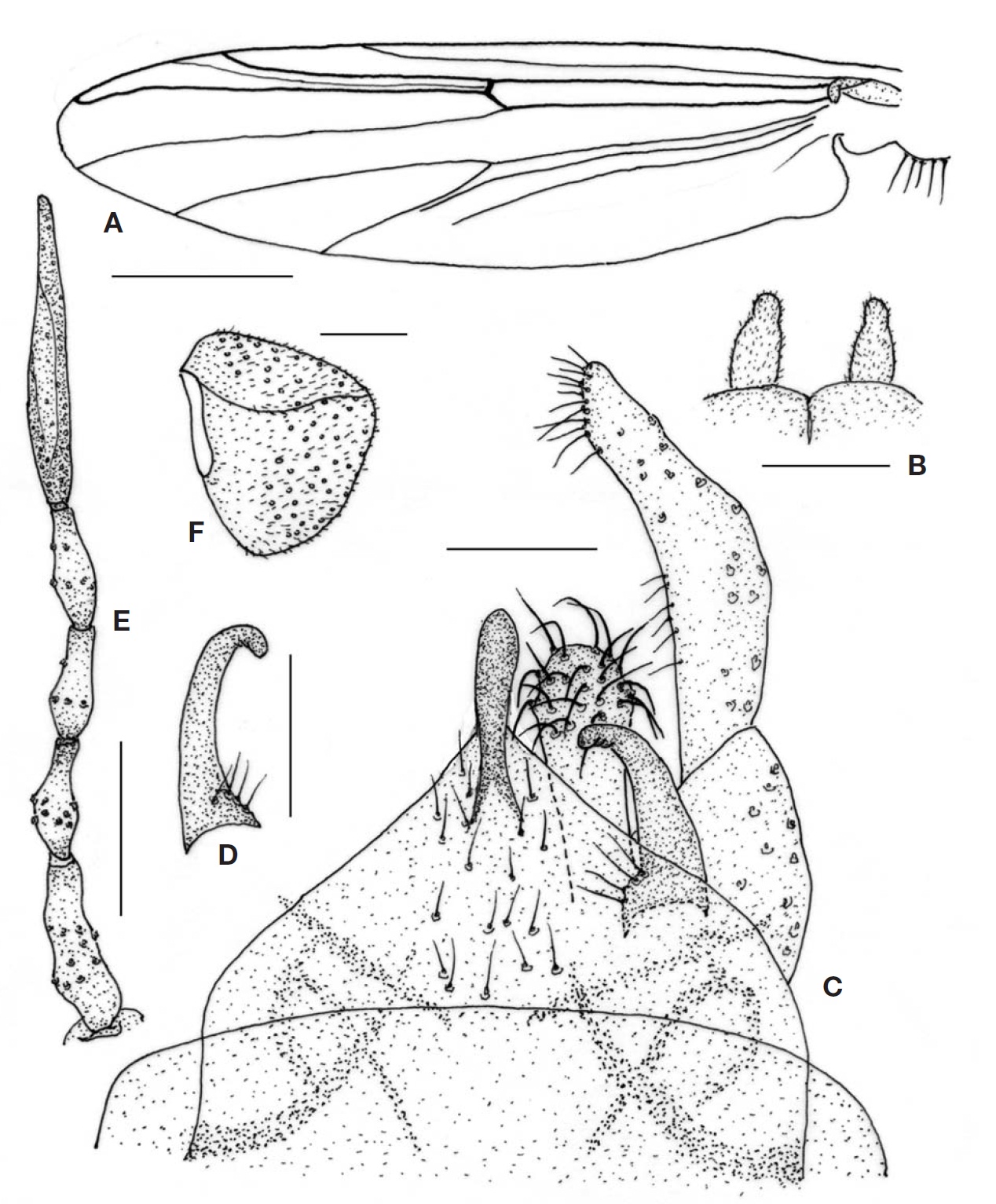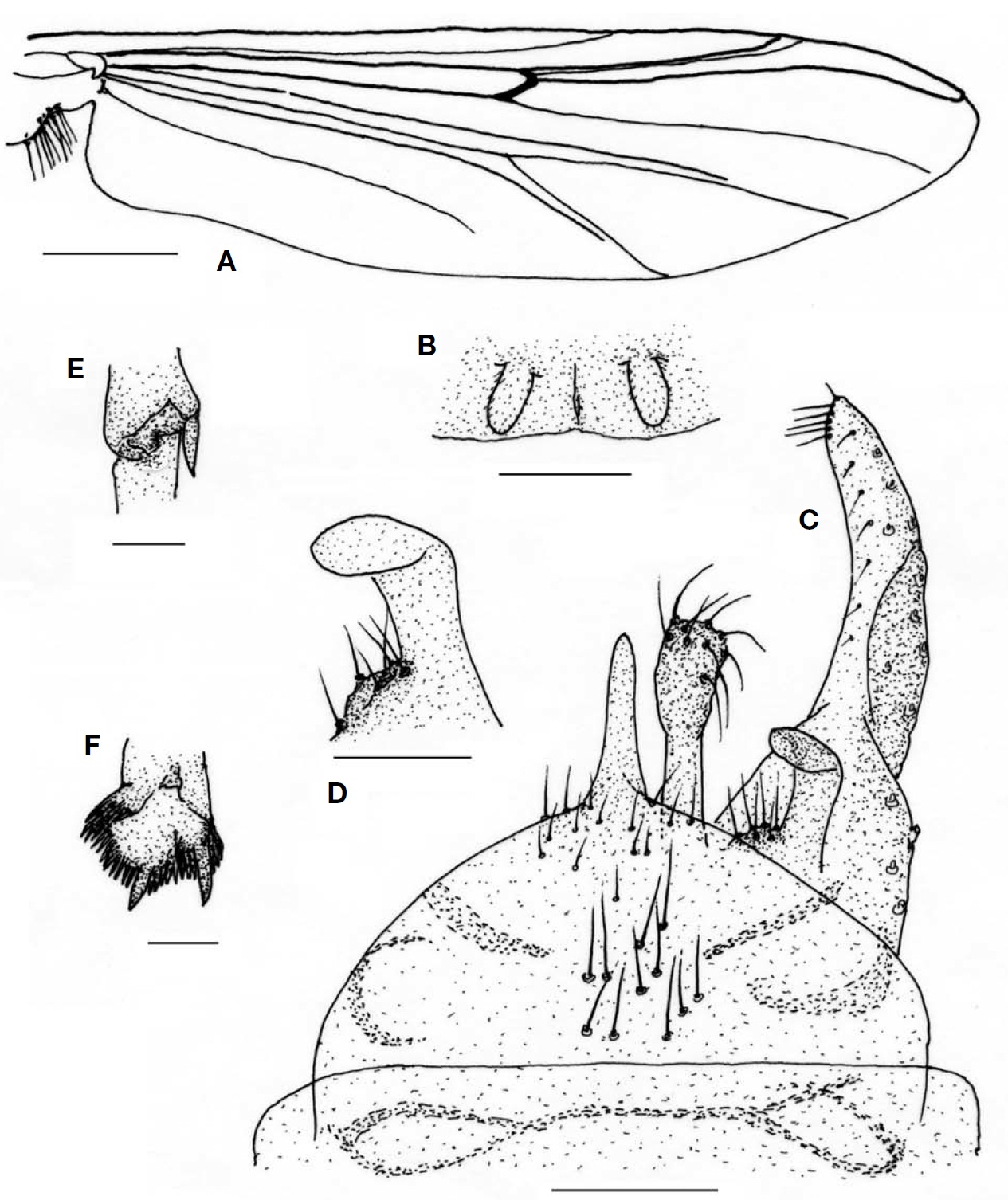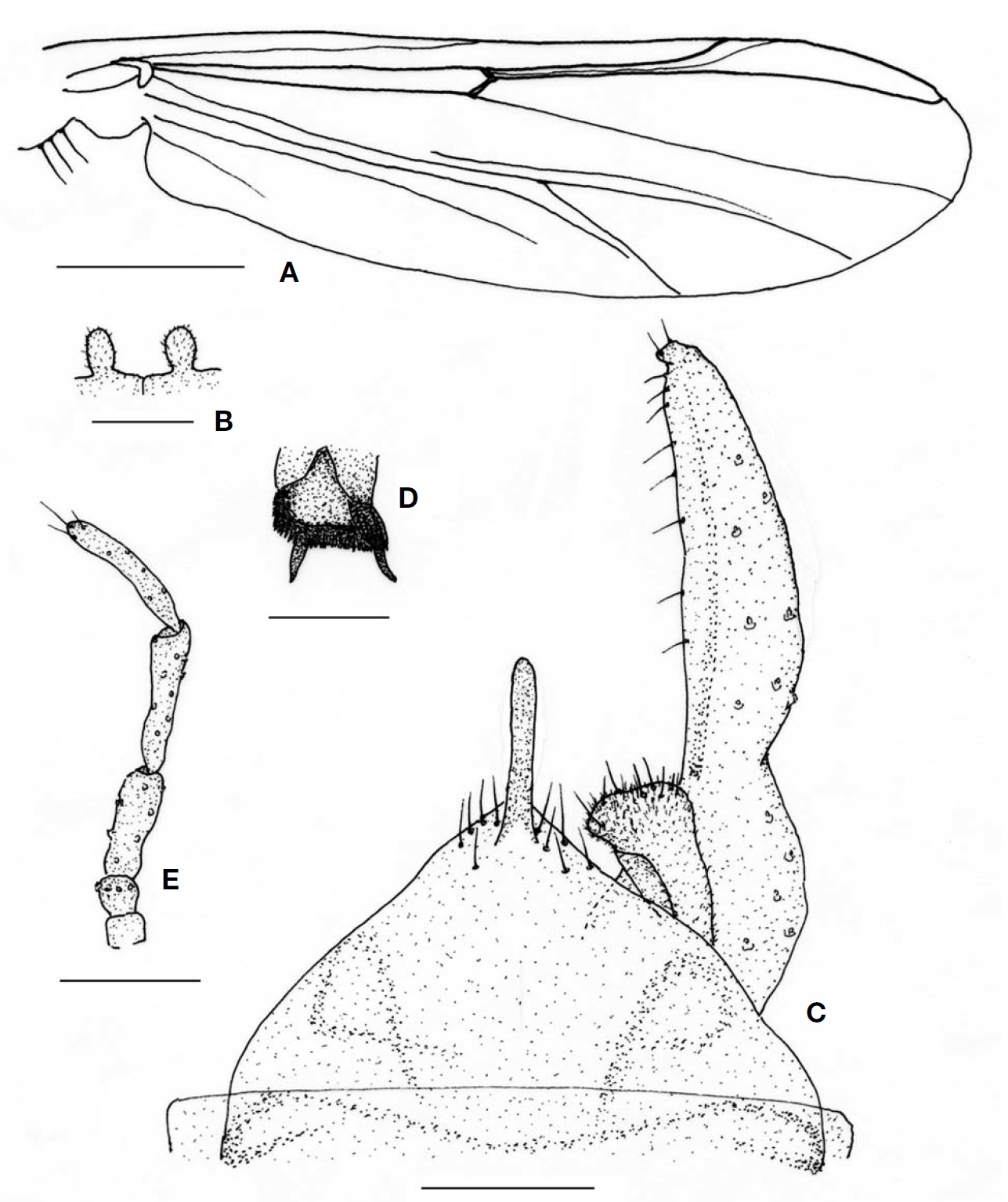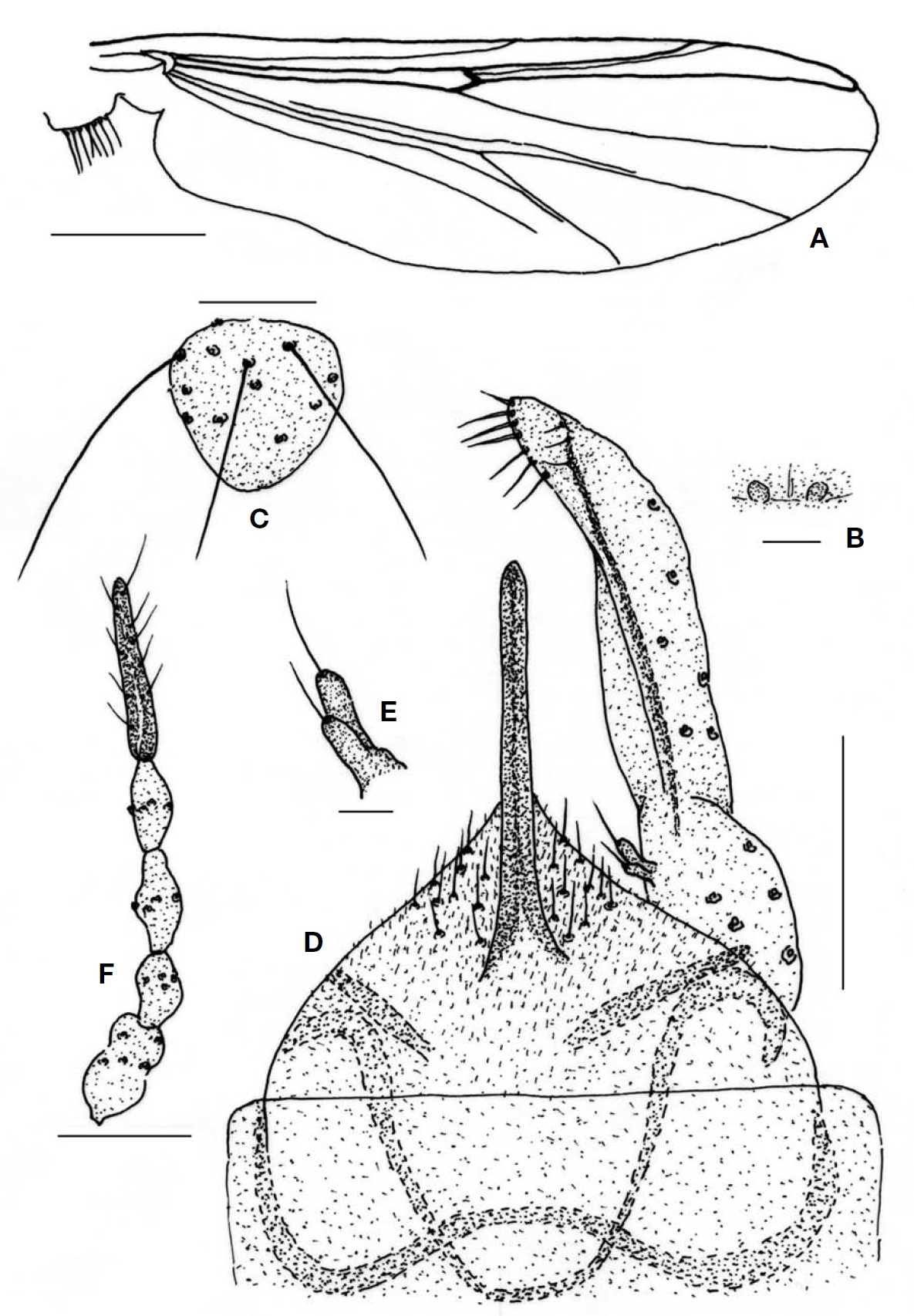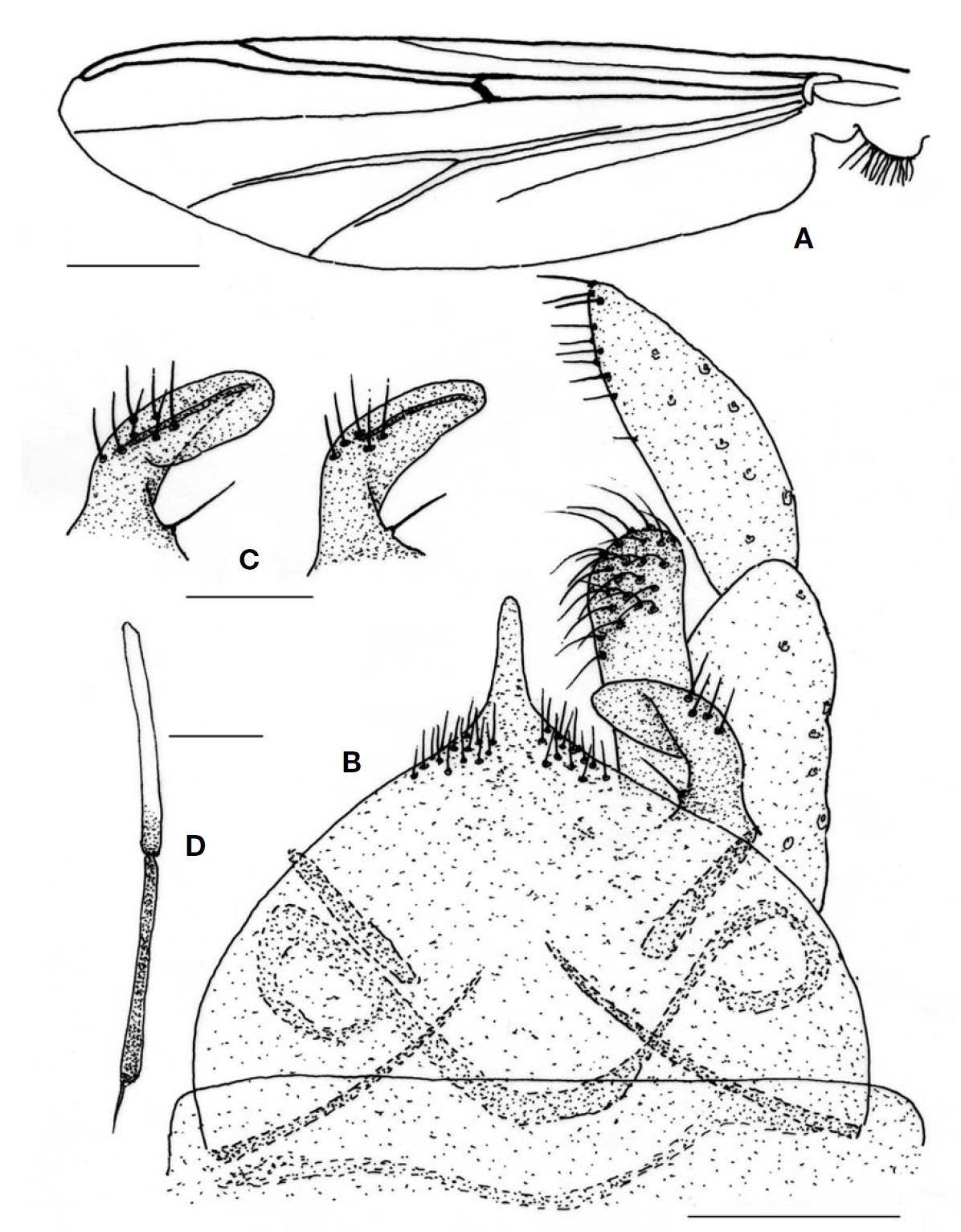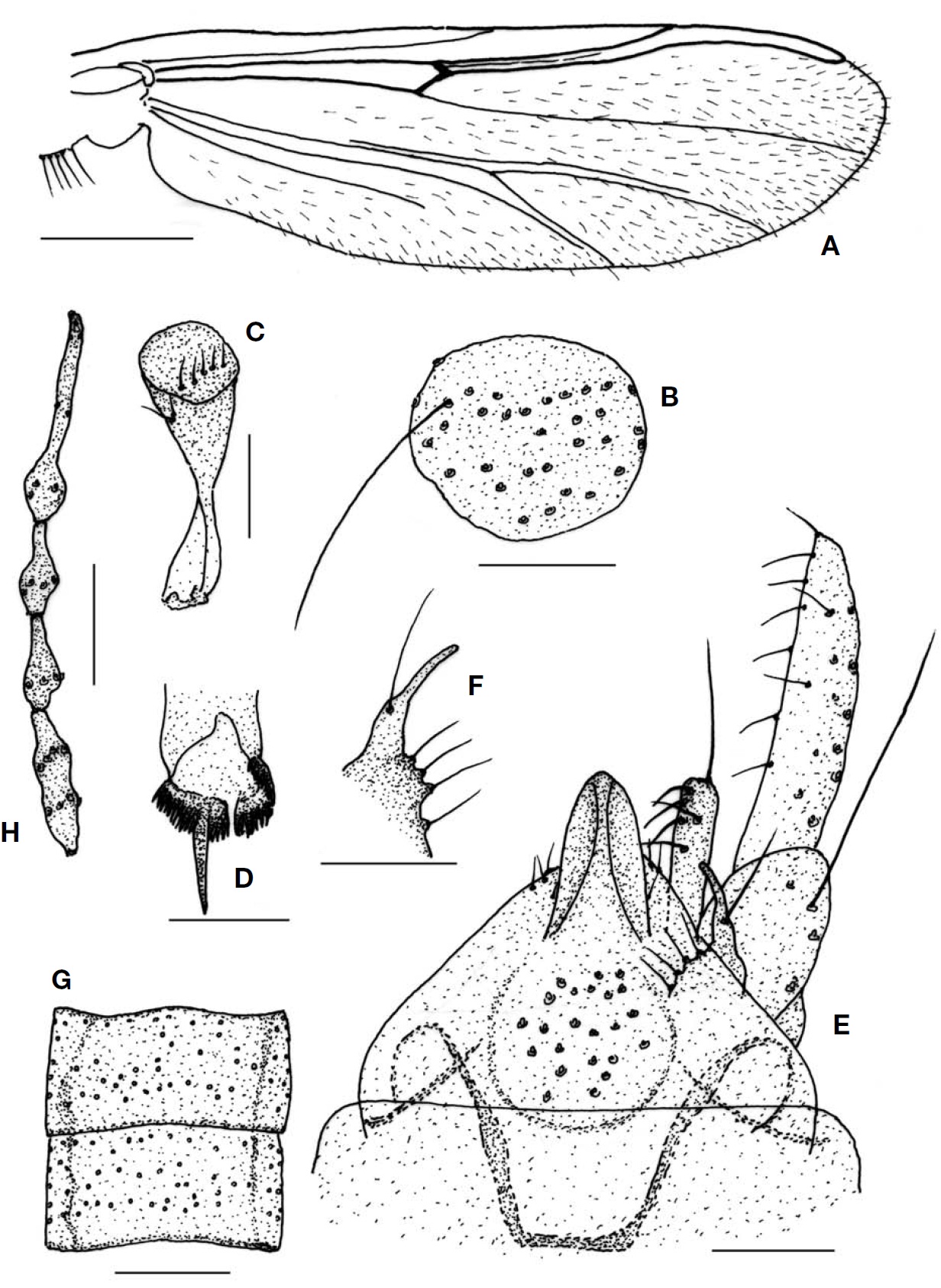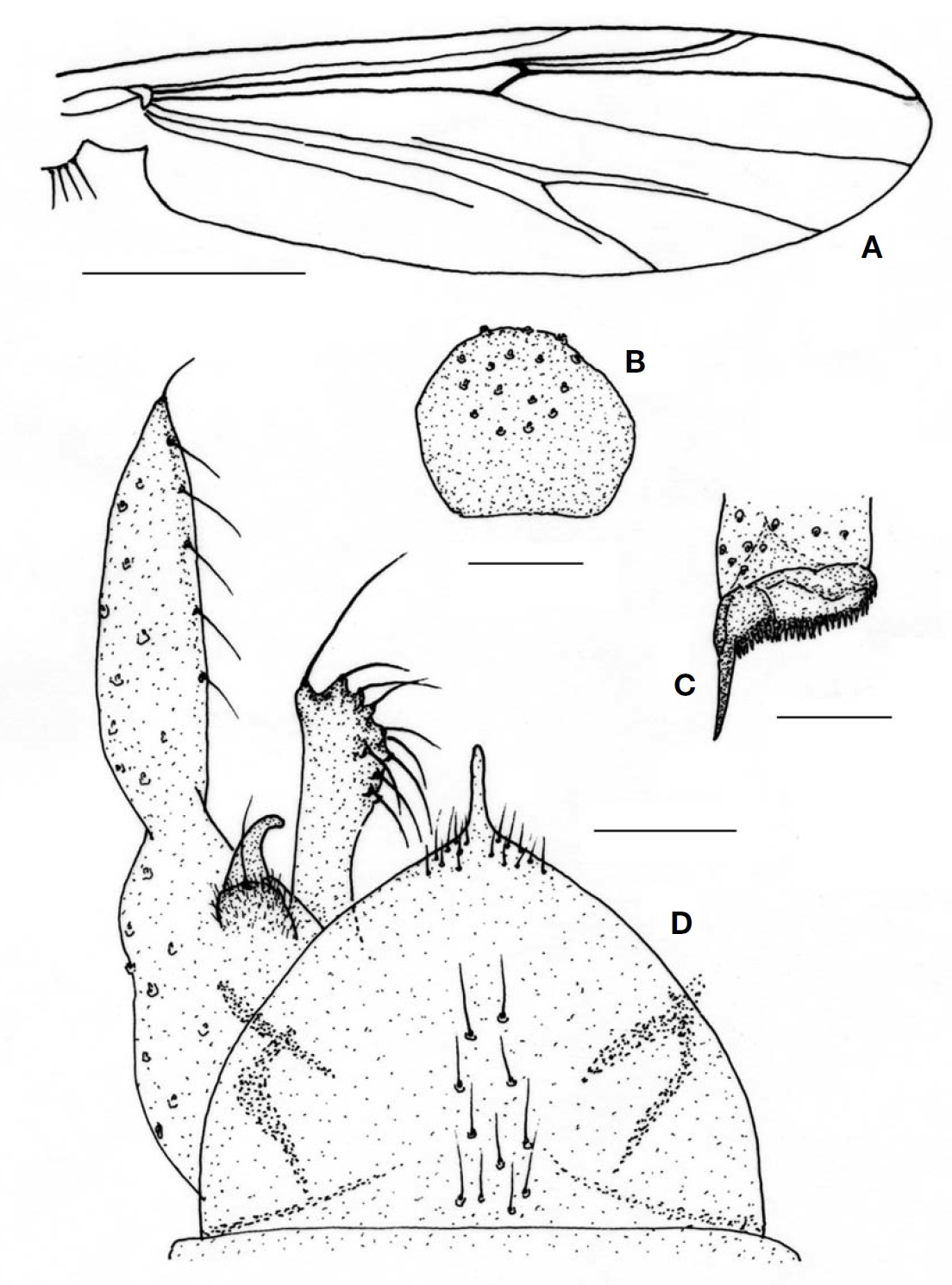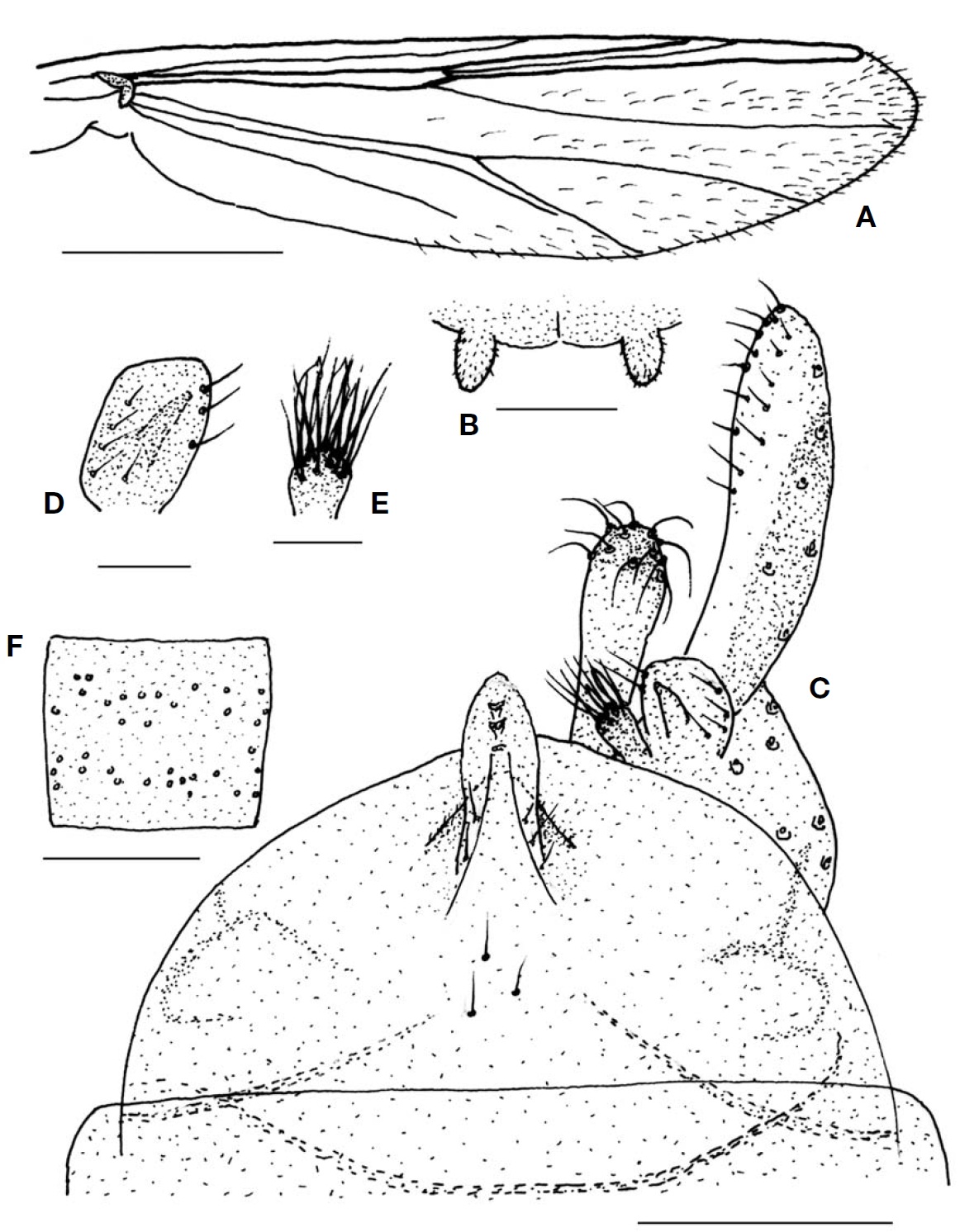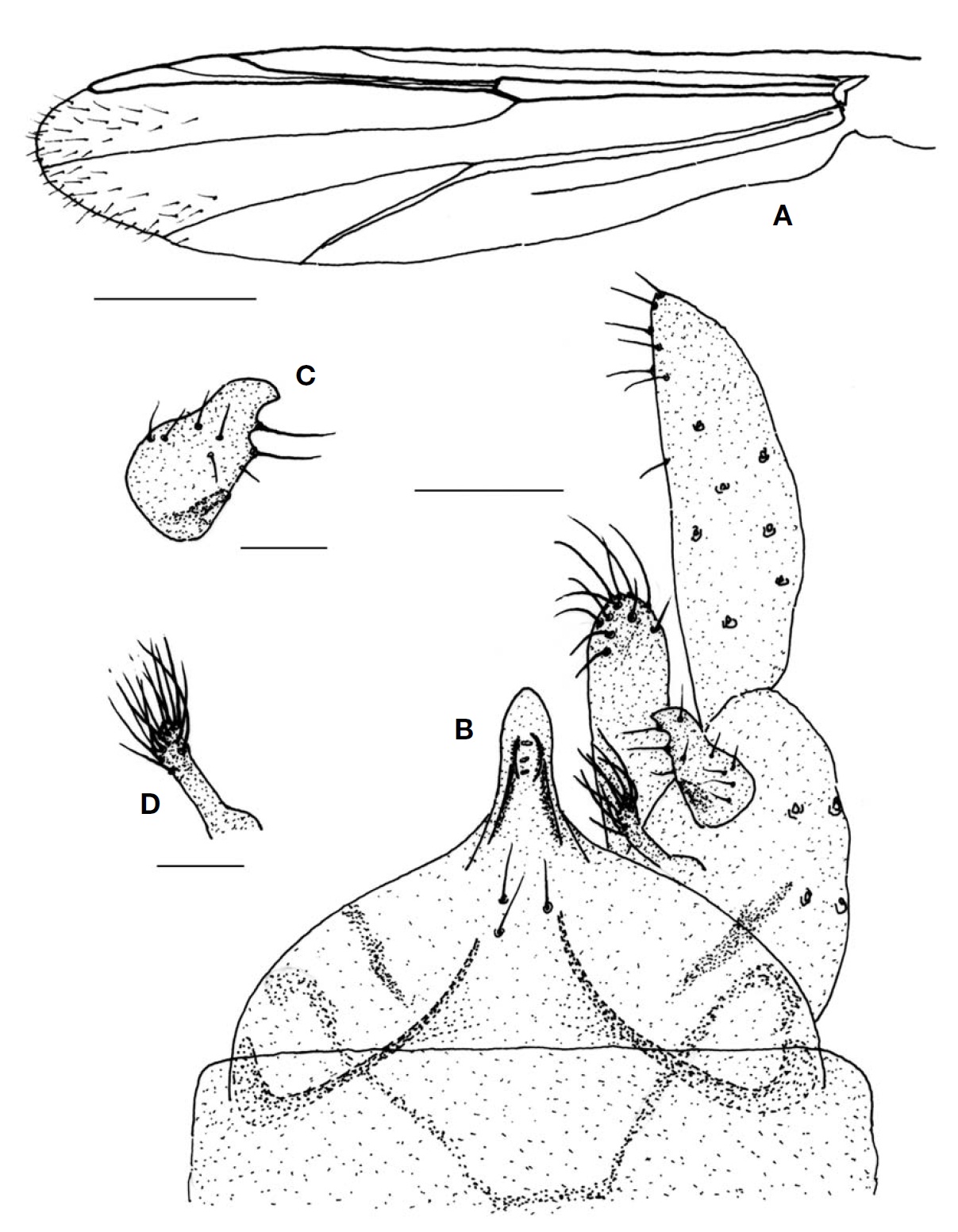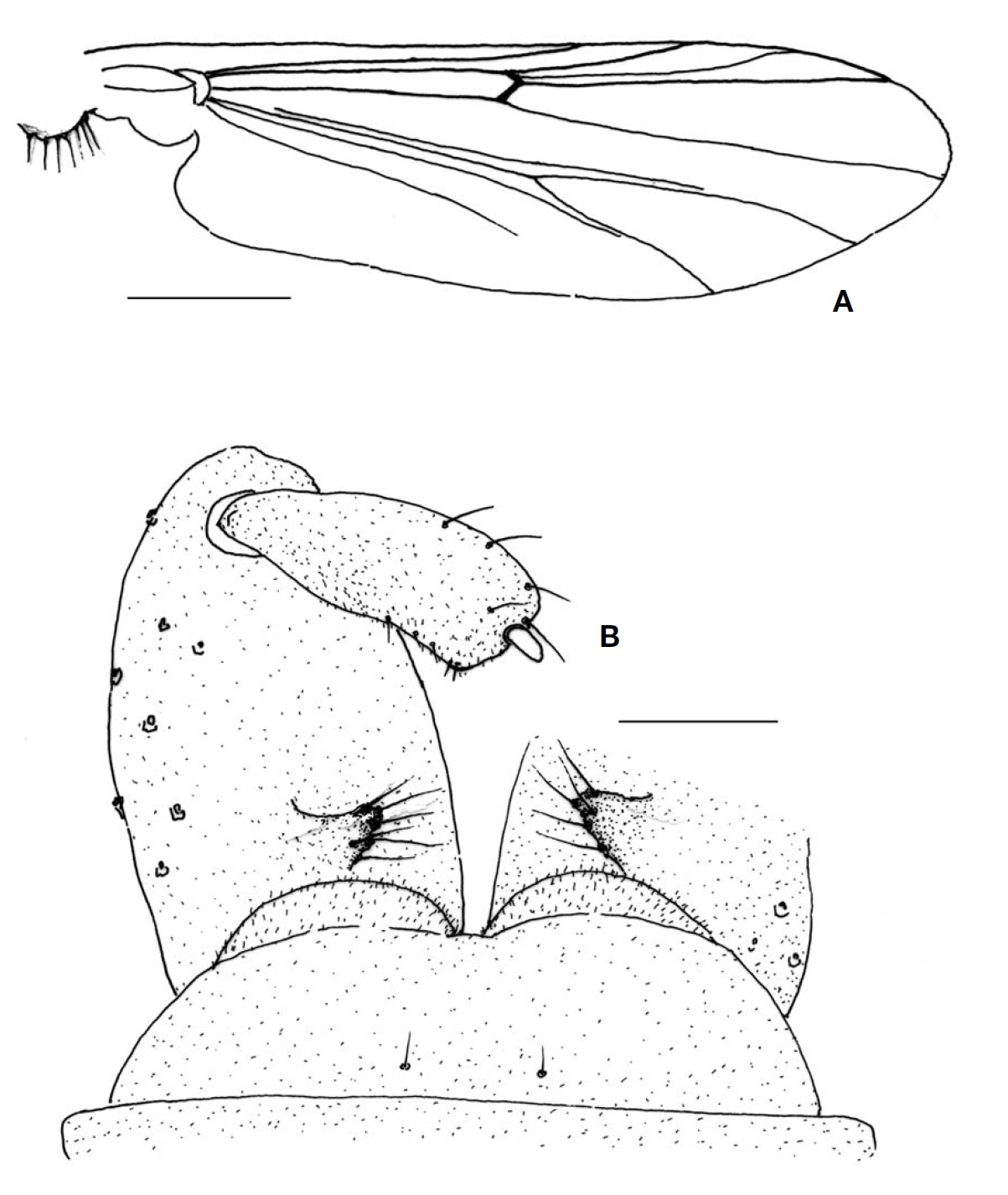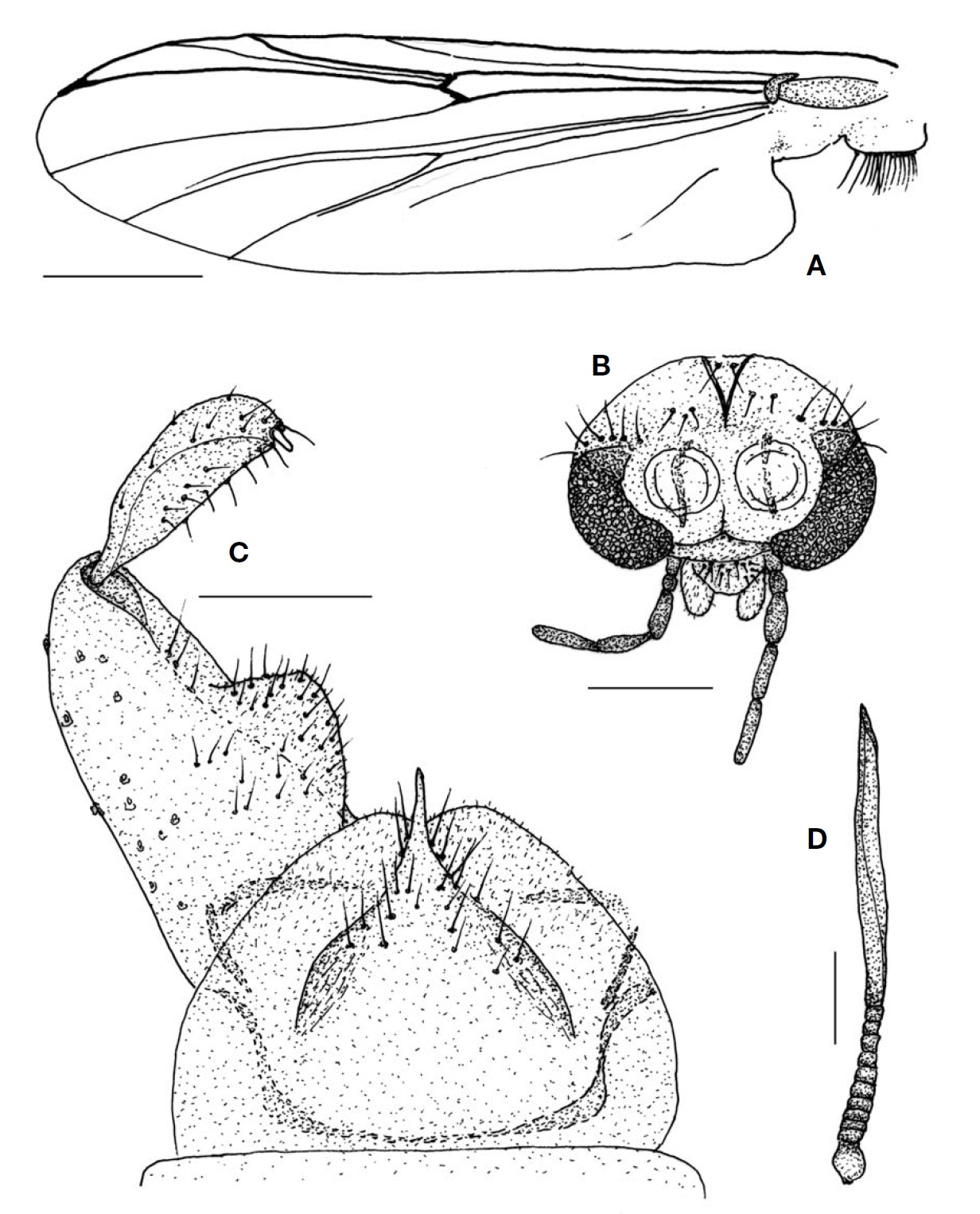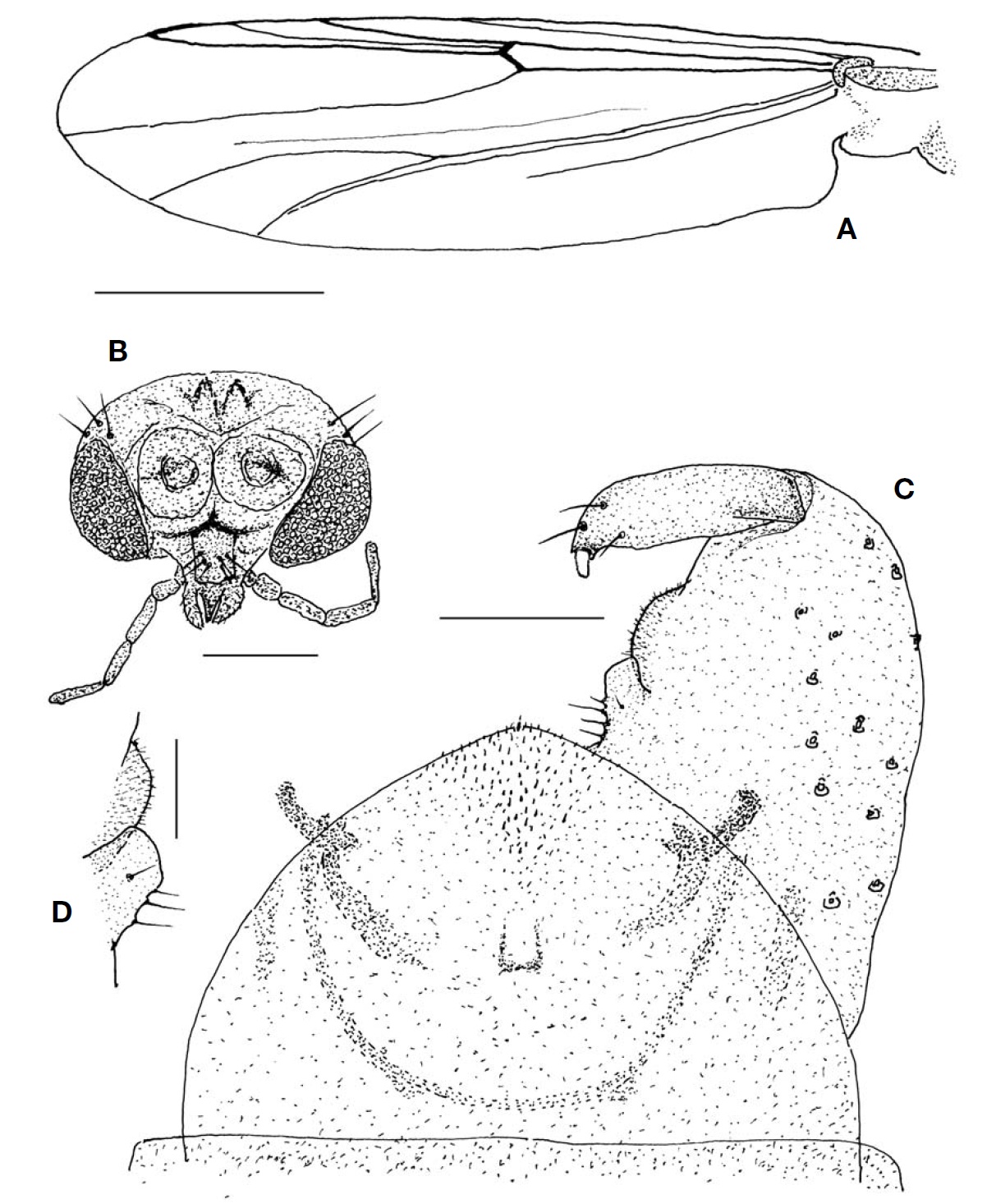



There are numerous species of non-biting midges (Diptera: Chironomidae). Chironomid larvae develop in almost all kinds of water sources. Because of their enormous numbers, fast growth and short life span, they are well-known nuisance insects, and also play an important role in allergic diseases (Kay et al., 1978; Lee et al., 1995; Yong et al., 1999). Very little historical information about Korean chironomids was available. In 1968, only one species of Chironomidae,
Chironomid adults were collected by sweeping with an insect net on grasses around breeding places during daytime hours. Swarming males were collected by sweeping an insect net in the evenings. Light traps were operated at night. Chironomid adults attracted to light and resting on the walls and windows of stores, restaurants, and official buildings were aspirated using a sucking tube. The collected specimens were preserved in 75% ethanol.
The antennae, head, wings, abdomen and hypopygium of each specimen preserved in 75% ethanol was dissected using two fine dissecting needles under a stereomicroscope, and mounted on either phenol balsam mounting media or Hoyer’s solution. Terminology follows Sæther (1980).
Measurements of slide mounted specimens were obtained from observing the specimens with a compound microscope equipped with a micrometer. The values were transformed to mm or μm using the scale of the micrometer. The length of the wing was measured from the apex of the wing to the acrista, which represents the size of the body. The antennal ratio (AR) was calculated by dividing the length of the longest flagellar segment plus any segment distal to it by the combind length of the remaining segments of the flagellum, not including the pedicel. Leg ratio (LR) was calculated by dividing the length of the first tarsal segment by the length of the tibia of the fore leg. Abbreviations used for wing length, radius-medial cross veins, and forked Cu are WL, RM, and FCu, respectively.
The type specimens were deposited in the collection of Arthropods of Medical Importance Resourse Bank, Department of Environmental Medical Biology, Yonsei University.
Order Diptera
Family Chironomidae Holiday
Subfamily Chironominae Macquart
Genus Chironomus Meigen
1*Chironomus fujiprimus Sasa, 1985 (Fig. 1)
Material examined. 20♂♂, 6♀♀, Korea: Gyeonggi-do, Yoju-gun, Gumsa-myeon, 29 Sep 2009, Song KH.
Diagnosis. Greenish yellow, large species (WL 4.0 mm). Superior volsella hooked at tip, with 7-8 setae at base. Gonostylus tapered apically, with 12-14 irrgular setae on innerlateral tip. LR 1.30.
Description (male). Head: Eye bare, strongly produced dorsomedially. Frontal tubercle rather small, tip narrowed, forming nipple shape (Fig. 1B). Clypeus yellow, with 32- 35 setae. Palp pale dark brown, with 4 segments: 83, 259, 259, 403 μm(1 : 3.1 : 3.1 : 4.9).
Female. Same as male, except for the usual sexual differences. Antenna (Fig. 1E) pale orange yellow, with 5 segments (1st and 2nd segments fused): 93, 61, 61, 61, 168 μm. Cercus as shown in Fig. 1F. WL 4.2 mm.
Distribution. Japan, Korea.
Remarks. All antennae of the examined specimens were lost, so the AR could not measured. The reported AR of the Japanese specimens is 3.57 (Sasa, 1985). The key characters of Korean specimens are consistent with those of Japanese specimens except for a small difference in the LR value (1.30 vs. 1.45, respectively).
2*Chironomus jangchungensis sp. nov. (Fig. 2)
Material examined. Holotype: ♂ (RCH-6203), Korea: Seoul, Jung-gu, Jangchung-dong, 8 Oct 1979, Ree HI. Paratypes: 10♂♂, same as holotype.
Diagnosis. Pale yellow, medium to large species (WL 3.15 mm). Anal tergite produced distally, with 12-14 short, pale apical setae and 11 long pale median setae. Anal point moderately long, bent upward. Apical bare blade of superior volsella with broad, round apex, abruptly bent upward, and 4- 5 irregularly arranged setae at base. AR 2.91. LR 1.62.
Description (male). Head: Eye bare, produced dorsomedially. Antenna yellowish brown, with 11 segments. AR 2.91. Frontal tubercle moderately large (Fig. 2B). Palp pale yellow, with 4 segments: 61, 243, 214, 196 μm(1 : 4.0 : 3.5 : 3.2). Clypeus pale yellow, roughly round, with 27 strong, pale setae on dorso-central site. Thorax: Pale yellow on ground color. Antepronotum pale yellow, developed. Scutum pale yellow, vittae absent, 6 prealars. Scutellum pale, with 22 setae. Postnotum pale yellow. Wing (Fig. 2A): WL 3.15 mm. Membrane bare, transparent. All veins bare, except R, R1 and R4+5. Costa not produced. R4+5 almost reach wing apex, far beyond M3+4. RM pale, proximal to FCu. Anal lobe developed. Squama with 17-20 setae. Arculus and brachiolum pale. Legs: All segments uniformly pale yellow. Fore tibia with a pale, sharply pointed spur (Fig. 2E); mid and hind tibial combs contiguous, each with a short spur (Fig. 2F). Pulvillus large. LR 1.62. Abdomen: Uniformly pale yellow. Hypopygium (Fig. 2C): Anal tergite moderately produced distally, with 12-14 short, pale apical setae
around base of anal point and 11 long, pale median setae; apodemes not distinct. Anal point moderately long, bent upwards. Superior volsella with apical bare blade, broad, round apex, abruptly bent upward, and 4-5 irrgularly arranged setae at base. Inferior volsella cylindrical, slightly expanded at apex, with 12-15 recurved setae. Gonostylus narrow,
slightly tapered distally, with 1 short apical and 4-5 subapical inner setae.
Female. Unknown.
Etymology. This species named after the type locality (Jangchung- dong).
Distribution. Korea.
Remarks. This new species is easily distinguishable from other species of the genus
Genus Demicriptochironomus Lenz
1*Demicryptochironomus paracamptolabis sp. nov. (Fig. 3)
Material examined. Holotype: ♂ (RCH-7053), Korea: Jeollabuk- do, Muju-gun, Muju-eup, Dangsan-ri, 28 Aug 2009, Jeong KY, Nam SH. Paratypes: 29♂♂, same as holotype.
Diagnosis. Small to medium (WL 1.3 mm), yellowish pale species. Anal tergite triangular, strongly produced distally; 5-7 apical setae each side of anal point; median setae absent. Anal point narrow, parallel-sided, with round tip. Superior volsella pediform, covered with microtrichiae and several short apical setae. Inferior volsella absent. Gonostylus long, slightly tapered apically, with weak longitudinal keel, AR 1.63. LR 1.84.
Description (male). Head: Eye bare, widely produced dorsomedially. Frontal tubercle moderately developed (Fig. 3B). Antenna brownish yellow, 11 segmented. AR 1.63. Palp (Fig. 3E) brownish pale yellow, with 5 segments: 29, 36, 95, 119, 125 μm(1 : 1.2 : 3.3 : 4.1 : 4.3). Clypeus yellow, with 13 setae on dorsal half. Thorax: Light yellow in ground color. Antepronotum slightly narrow dorsally, notched medially. Scutum light yellow, with deep yellow vittae; 13 long, erect acrositicals; 7-9 dorsocentrals, arising from small pit. Scutellum pale yellow, with 7 uniserial setae. Postnotum yellow. Wing (Fig. 3A): WL 1.3mm. Membrane bare, greyish yellow in color. All veins bare, except R1 and basal R1+2. Costa not produced. R2+3 distinct, ending near R1+2. R4+5 distal to M3+4. FCu distal to RM. Cu1 straight. Anal lobe not developed. An reaching below FCu. Squama with 3 setae. Brachiolum and arculus pale, without seta. Legs: Fore femur pale yellow, slightly darker distally; fore tibia and tarsi I-V yellowish brown. Mid and hind femur, tibia and tarsi I-III pale yellow, tarsi IV-V darker. Mid and hind tibial combs contiguous, each with a spur (Fig. 3D). Pulvillus distinct. LR 1.84. Abdomen: Uniformly pale. Hypopygium (Fig. 3C): Anal tergite triangular; median setae absent; 4-5 apical setae each side of anal point; anal tergal band poorly developed. Anal point long, narrow, parallel-sided. Superior volsella pediform, covered with microtrichiae and several short setae apically, Inferior volsella absent. Gonocoxite short. Gonostylus long, slightly tapered apically, with irregularly arising short setae on distal inner-margin, and weekly developed keel.
Etymology. The specific name
Distribution. Korea.
Female. Unknown.
Remarks. The structure of hypopygium of this new species is similar to that of
2*Demicryptochironomus wontongensis sp. nov. (Fig. 4)
Material examined. Holotype: ♂ (RCH-2674), Korea: Gangwon-do, Inje-gun, Wontong-myeon, 2 Oct 1988, Ree HI. Paratypes: 4♀♀ (RCH-2675, 2677, 2679, 2693), same as holotype.
Diagnosis. Brownish yellow, medium-sized species (WL 2.3 mm). Anal point very long, narrow, paralled-sided, with 10-11 apical setae each side. Superior volsella small, 2 figerlike lobes, subequal, each lobe with an apical seta. AR 2.65. LR 1.47.
Description (male). Head: Brownish yellow. Eye brown, bare, dorsomedially extended. Frontal tubercle minute (Fig. 4B). Antenna pale dark brown (1st-3rd segments pale), with 11 segments. AR 2.65. Palp pale dark brown, with 4 segments: 40, 144, 158, 158 μm(1 : 3.6 : 3.9 : 3.9). Clypeus (Fig. 4C) shield-like, brown, with 12 long setae, Thorax: Yellowish brown in ground color. Antepronotum moderately developed. Scutum yellowish brown, without vittae; 14 acrosticals; 11-12 dorsocentrals and 4 prealars each side. Scutellum pale yellow, with 19 setae. Haltere pale. Wing (Fig. 4A): WL 2.3 mm. Membrane bare. All veins pale, without seta, only R, R1 and R4+5 with setae. Costa not extended from R4+5. R2+3 end near R1. R4+5 far distal to M3+4. FCu slightly distal to RM. Cu1 straight. Anal lobe moderately developed. Squama fringed. Arculus pale, brachiolum pale with 2 long setae. Legs: Foreleg dark brown, except pale femur; mid-and hindlegs pale, except for darker tip (tarsi III-V). Mid and hind tibial combs contiguous, each with a short spur. Pulvillus large. LR 1.47. Abdomen: All segments pale yellow. Hypopygium (Fig. 4D): Anal tergite produced distally (triangular in form), with 10-11 apical setae each side of anal point; median setae absent; anal tergal band absent; transverce sternapodeme smoothly rounded. Anal point long (300 μm), narrow, parallel-sided. Superior volsella small, 2 subequal, finger- like lobes, each with an apical spur (Fig. 4E). Inferior volsella absent. Gonocoxite small. Gonostylus long, slightly
swollen inner-basally, tip smoothly rounded with 1 apical and 3 subapical strong, pale setae; longitudinal keel present dorsally.
Female. Generally same as male, except for the usual sexual differences. Antenna 5 segmented; 1st-4th segments pale, 5th segment dark brown (Fig. 4F).
Etymology. The new name refers to the locality where this species was collected.
Distribution. Korea
Remarks. This new species is easily distinguishable from other species of
Genus Microtendipes Kieffer
1*Microtendipes paratamagouti sp. nov. (Fig. 5)
Material examined. Holotype: ♂ (RCH-6293), Korea: Jejudo, Seoguipo-si, Jungmun-dong; 2 Oct 2008, Ree HI, Jeong KY. Paratypes: 1♂ (RCH-3671), Gyeongsangbuk-do, Gimcheon- si, Daehang-myeon, Jikji Temple, 18 Oct 1996, Ree HI; 5♂♂ (RCH 6270, 6272, 6279, 6288, 6296), same as holotype.
Diagnosis. Brownish, large species (WL 2.9 mm). Anal tergite large, hemisphere, without median seta. Anal point rather short, slightly tapered apically, with round tip. Superior volsella broadly expanded on distal half, with 4-7 dorsal setae on middle and 1 seta at inner base. Tibia of foreleg dark, with narrow, long apical spur. AR 1.92, LR 1.17.
Description (male). Head: Brownish yellow. Eye black, bare, extended dorsomedially. Frontal tubercle absent. 10- 11 postoculars each side. Antenna yellowish dark brown, with 13 segments. AR 1.92. Palp dark brown, with 5 segments: 47, 65, 302, 281, 346 μm(1 : 1.4 : 6.4 : 6.0 : 7.4); first segment narrower than second one. Clypeus brown, with 19 setae. Thorax: Brown in ground color. Antepronotum moderately developed, narrow dorsally, without setae. Scutum brown, with dark brown vittae (not clearly defined); acrosticals absent; 4 prealars. Scutellum dark brown, with 15 setae. Postnotum dark brown. Preepisternum dark brown. Haltere pale. Wing (Fig. 5A): WL 2.9 mm. Membrane bare, transparent. Costa not extended from R4+5. R2+3 running very close to R1 (apical end of R2+3 almost overlap to R1). Veins all pale, transparent, setae only on R, R1. R4+5 distal to M3+4. FCu distal to RM. Cu1 straight. Anal lob moderately developed. Squama with 14 setae. Arculus and brachiolum pale. Legs: Fore leg: femur pale with dark brown tip, fore tibia uniformly dark brown (Fig. 5D), tarsi I-II pale yellow, tarsi III-V darker. Mid and hind legs: all segments pale yellow. Fore tibia with an extremely long, narrow spur at tip; mid and hind tibial combs contiguous, with a rather small spur, curved at tip. Pulvillus developed. LR 1.17. Abdomen: Tergite I-V pale yellow; tergite VI-VIII deep yellow. Hypopygium (Fig. 5B): Anal tergite large, hemispheric-shaped, with 11-14 rather short, apical setae each side of anal point; median setae absent; anal tergal band V-type; all apodemes dark brown, well developed. Anal point rather short, slightly tapered apically, with round tip. Broadly expanded distal half of superior volsella curved inward, with 4-7 dorsal setae at middle and 1 seta at base. Inferior volsella cylindrical, with many setae on distal half. Gonostylus rather short (shorter than gonocoxite), with 3 strong setae apically.
Female. Unknown.
Etymology. This species name refers to closely related species,
Distribution. Korea.
Remarks. Superior volsella of this species shows considerable variation in the shape of the distal half and the number of dorsal setae (Fig. 5C). This new species is closely related to
Genus Pentapedilum Kieffer
2*Pentapedilum convexum (Johannsen, 1932) (Fig. 6)
Material examined. 11♂♂, 1♀, Korea: Jeju-do, Seoguiposi, Jungmun-dong, 1 Oct 2008, Ree HI, Jeong KY.
Diagnosis. Yellowish, small to medium sized species (WL 1.4 mm). Wing membrane covered with macrotrichiae, except at base. Clypeus round with 32 extraordinarily long setae. Round apex of haltere with 5 setae. Anal point short, broad, with round tip. Superior volsella extremely narrow, a long outer-lateral seta at middle, with 4 setae at inner base. AR 0.43. LR 2.41.
Description (male). Head: Yellowish brown. Eye bare, moderately extended to dorsomedially. Antenna yellowish brown, 12 segmented (1st and 2nd segment fused). AR 0.43. Frontal tubercle absent. 9-11 postoculars each side. Clypeus brownish yellow, round, with 32 long, stout setae (Fig. 6B). Palp pale dark brown, with 5 segments: 29, 39, 85.7, 121, 214 μm(1 : 1.4 : 3.0 : 4.3 : 7.5). Thorax: Antepronotum brownish yellow, narrowed dorsally. Scutum brownish yellow, with
inconspicuous brown vittae; 19 biserial acrosticals; 24-25 dorsocentrals and 7-9 prealars each side. Scutellum brownish pale yellow, with 19 setae. Postnotum brown. Haltere pale dark brown, with 7 setae (Fig. 6C). Wing (Fig. 6A): WL 1.4 mm. Membrane covered with macrotrichiae. Almost all veins with setae. Costa not produced. R2+3 not distinct. R4+5
beyond M3+4. RM proximal to FCu. Cu1 straight. An scaresly reaching FCu. Anal lobe not developed. Squama with setae. Legs: All segments brownish yellow. Mid and hind tibial combs narrowly separated, with a long spur (Fig. 6D). LR 2.41. Abdomen: All segments uniformly pale yellow, with vertical dark stripe each side of tergum. Setal arrangement and longitudinal stripe as shown in Fig. 6G. Hypopygium (Fig. 6E): Anal tergite triangularly produced distally; 26 long median setae; several short apical setae each side of anal point. Anal point broad, with round tip and deep keel ventrally. Superior volsella with extremely narrow apical blade, a long outer lateral seta at middle and 4 setae at inner base (Fig. 6F). Inferior volsella cylindrical with a long seta and 5-7 recurved setae apically. Gonostylus straight, apically tapered, with round tip.
Female. Generally same as in male, except for usual sexual differences. Antenna (Fig. 6H) brown, with 4 segments (first and second segment fused).
Distribution. Europe, Indonesia, China, Russian Far East, Japan, Korea.
Remarks.
Genus Polypedilum Kieffer
1*Polypedilum macrohemisphere sp. nov. (Fig. 7)
Material examined. Holotype: ♂ (RCH-7011), Korea: Jeollabuk-do, Muju-gun, Muju-eup, Dangan-ri, 28 Aug 2009, Jeong KY, Nam SH. Paratypes: 2♂♂ (RCH-6364, 6635), same as holotype, except date 5 Sep 2008.
Diagnosis. Small to medium-sized (WL 1.8 mm), pale yellow species. Clypeus round, with 16 setae arising on dorsocentral site. Anal tergite extraordinarily large, roundly produced distally, with 10-11 apical setae each side of anal point. Anal point small, narrow, parallel-sided. Superior volsella with short, narrow, abruptly curved apical blade, and broad basal half covered with microtrichiae and 1 seta. AR 1.67. LR 1.75.
Description (male). Head: Eye bare, produced dorsomedially. Frontal tubercle absent. Antenna yellowish brown, with 13 segments. AR 1.67. Clypeus yellow, with 16 setae arising on dorsocentral site (Fig. 7B). Palp pale brownish yellow, with 4 segments: 43, 107, 104, 143 μm(1 : 2.5 : 2.4 : 3.3). Thorax: yellow in ground color. Antepronotum yellow, narrowed dorsally, Scutum yellow, vittae absent; 12 acrosticals; 15-16 dorsocentrals and 5 prealars each side. Scutellum pale yellow, with 20 setae. Postnotum brownish yellow. Haltere pale. Wing (Fig. 7A): WL 1.8mm. Membrane bare. Costa not produced. R2+3 ending near tip of R1. R4+5 distal to M3+4. FCu distal to RM. Cu1 straight. Postcubitus distinct. An scarcely reaching FCu. Anal lobe moderately developed. Squama with setae. Arculus pale, brachiolum pale with 1 seta. Legs: Uniformly pale yellow; foreleg slightly darker. Mid and hind tibial combs contiguous, with 1 long spur (Fig. 7C). Pulvillus not developed. LR 1.75. Abdomen: All segments pale yellow. Hypopygium (Fig. 7D): Anal tergite extraordinarily large, roundly produced distally; 11 median setae; 10-11 apical setae each side of anal point; phalapodeme and lateral sternoapodeme pale; anal tergal band poorly developed. Anal point rather short, narrow, paralle-sided. Superior volsella with short, narrow, abruptly curved apical blade and broad basal half covered with microtrichiae and 1 seta. Inferior volsella cylindrical, with 1 long seta and 10-12 strong, recurved setae apically. Gonostylus tapered distally, with pointed tip.
Female. Unknown.
Etymology. The species name refers to large, hemispheriform anal tergite.
Distribution. Korea.
Remarks. This new specie is characterized by the extraordinarily small anal point, large hemispheriform anal tergite, and small, unique shape of superior volsella.
Genus Tanytarsus v.d. Wulp
2*Tanytarsus smolandicus Brundin, 1947 (Fig. 8)
Material examined. 4♂♂, Korea: Jeollabuk-do, Mujugun, Muju-eup, Dangsan-ri, 5 Sep 2008, Jeong KY, Nam SH; 8♂♂, same locality, 22 May 2009; 5♂♂ same locality, 28 Aug 2009.
Diagnosis. All body color pale yellow, small to medium species (WL 1.8 mm). Wing membrane with macrotrichiae mostly on apical half. Anal tergite rounded distally, with 3 minute median setae. Anal point slightly broadened at middle, with 2-3 weak spines and anal crest. Superior volsella small, round, with 5-6 dorsal and 8-9 ventral setae; digitus short, not produced from margin of superior volsella. Median volsella short, with 2-3 lamellar and many simple setae. AR
1.22. LR 3.05.
Description (male). Head: Eye bare, shortly extended dorsomedially. 7-8 postoculars. Frontal tubercle moderately short (Fig. 8B). Antenna yellowish brown, with 13 segments. AR 1.22. Palp pale, 4 segmented: 36, 111, 118, 189 μm(1 : 3.1 : 3.3 : 5.3). Clypeus pale yellow, with 16 setae. Thorax: Pale yellow in ground color. Antepronotum pale yellow, narrowed dorsally, lobes widely separated. Scutum pale yellow,
vittae absent; 13 acrosticals; 6-8 dorsocentrals and 0-1 prealars each side. Scutellum pale yellow, with 4 setae. Postnotum pale yellow. Haltere pale. Wing (Fig. 8A): WL 1.8 mm. Membrane with macrotrichiae, mostly on distal half. All veins with setae, except subcosta and R2+3. Costa not produced. R4+5 slightly distal to M3+4. Anal lobe not developed. Squama bare. Arculus brown, brachiolum pale yellow with 1 seta. Legs: Uniformly pale yellow. Mid and hind tibi-al combs separated, each with a spur. Pulvillus absent. LR 3.05. Abdomen: All segments pale yellow, with irregularly arising 30-40 biserial setae (Fig. 8F). Hypopygium (Fig. 8C): Anal tergite roundly produced distally, with 2-3 short median setae; apodemes and anal tergal band not developed. Anal point short and wide, rounded apically, with 2-3 rather poor spines and distinct anal crest. Superior volsella (Fig. 8D) roughly spheric-shaped, with 2-3 inner-lateral setae, 4-5 dorsal short setae, and 8-9 ventral setae; digitus short, not extending beyond margin of superior volsella. Inferior volsella cylindrical, slightly expanded apically, with 10-13 rather short setae apically. Median volsella (Fig. 8E) very short, with 2-3 lamellar setae and many simple setae. Gonostylus slightly tapered apically, with irregular, short setae subapically.
Distribution. Europe, Korea.
Remarks. Morphological structures of the present species match those of
1*Tanytarsus oyamai Sasa, 1979 (Fig. 9)
Material examined. 5♂♂, Korea: Busan-si, Buk-gu, Daejeo- dong, 21 Jun 1979, Ree HI.
Diagnosis. Small to medium (WL 1.5 mm), brownish species. Wing membrane with macrotrichiae on apical end only. Anal point round at tip, with 2-3 poor spines between strong anal crests. Superior volsella tapered apically, with 2-3 innerlateral and 6-7 dorsal setae; with very small digitus present. Median volsella short, with simple setae only. AR 1.07. LR 1.70.
Description (male). Head: Brown in ground color. Eye bare, extended dorsomedially. 12-13 postoculars. Frontal tubercle present (36 μm long×10 μm wide). Antenna pale dark brown, with 13 segments. AR 1.07. Palp pale brownish yellow, with 5 segments: 36, 39, 100, 82, 112 μm(1 : 1.1 : 2.8 : 2.3 : 3.1). Clypeus brown, with 21 setae. Thorax: Light brown in ground color. Antepronotum dark brown, bare, narrowed dorsally. Scutum brown, with dark brown vittae; 7 acrosticals; 7-8 dorsocentrals each side; prealars absent. Scutellum brown, with 6 setae, Postnotum dark brown. Haltere pale dark brown. Preepisternum dark brown. Wing (Fig. 9A): WL 1.5 mm. Membrane with macrotrichiae on apical end. R2+3 ending at middle of R1 and R4+5. R4+5 distal to M3+4. FCu distal to RM. Cu1 straight. An scarcely reaching FCu. Anal lobe not developed. Squama bare. Arculus and brachiolum pale dark brown. Legs: Uniformly dark brown. Mid and hind tibial combs separated, each with a spur. Pulvillus not developed. LR 1.70. Abdomen: Uniformly pale dark brown. Hypopygium (Fig. 9B): anal tergite smoothly rounded, with 3 rather short median setae; apical setae absent; anal tergal band prominent, V-type; all apodemes developed. Anal point moderately broad, round at tip, with 2-3 poorly developed spines between strong anal crests. Superior volsella (Fig. 9C) tapered apically, with 2-3 inner-lateral setae and 6-7 dorsal setae; digitus small, not extending to margin of superior volsella. Median volsella (Fig. 9D) short, with many simple setae. Inferior volsella cylindrical with many apical setae. Gonostylus smoothly tapered apically, with irregularly arised setae apically and subapically.
Distribution. Japan, Korea.
Remarks. Morphological structures of the Korean specimens match those of
Subfamily Orthocladiinae Edwards
2*Genus Eukiefferiella Thienemann
3*Eukiefferiella busanensis sp. nov. (Fig. 10)
Material examined. Holotype: ♂ (RCH-4145), Korea: Busan- si, Buk-gu, Daejeo-dong, 15 Sep 1980, Ree HI. Paratypes: 19♂♂ same as holotype.
Diagnosis. Small to medium, yellowish pale species (WL 1.4 mm). Antenna and all veins of wing extremely pale, almost transparent. Anal tergite small, without any setae, except 2 minute median setae. Gonocoxal lobe rather small, triangular, with 5-6 setae. Gonostylus expanded distally, with a pale megaseta. AR 1.36. LR 0.56.
Description (male). Head: Eye bare, shortly extended dorsomedially. Frontal tubercle absent. Antenna extremely pale, almost transparent, with 13 segments. AR 1.36. Palp pale, with 5 segments: 36, 39, 84, 93, 150 μm (1 : 1.1 : 2.4 : 2.6 : 4.2). Clypeus pale yellow, more or less rectangular, with 11 pale setae. Thorax: Brownish yellow in ground color. Antepronotum pale yellow, well developed, without seta. Scutum brownish yellow, with inconspicuous brown vittae; acrosticals minute, difficult to observe. Scutellum yellow, with 4 pale setae. Postnotum brownish yellow. Haltere pale. Wing
(Fig. 10A): WL 1.4 mm. Membrane bare, transparent. All veins pale, almost transparent, without setae. Costa not produced. R2+3 ending at middle of R1 and R4+5. R4+5 distal to M3+4. FCu distal to RM. Cu1 almost straight. An reaching below FCu. Anal lobe moderately developed. Squama with setae. Brachiolum and arculus pale. Legs: All segments
extremely pale. Fore and mid tibiae with a rather short, pale spur apically; hind tibia with a long spur and comb spurs. Pulvillus absent, LR 0.56. Abdomen: All segments pale yellow. Hypopygium (Fig. 10B): Anal tergite rathr small, setae completely absent, except for 2 minute median setae. Anal point absent. Gonocoxite large; gonocoxal lobe rather small, triangular, with 5-6 setae. Gonostylus pale yellow, rather large, somewhat expanded distally, with a pale megaseta.
Female. Unknown.
Etymology. The new specific name refers to the name of city where this species was collected.
Distribution. Korea.
Remarks. This new species has an extremely pale body color, including wing veins. Anal tergite is extremely simple, no setae, except for 2 tiny median setae, and no apodemes and anal tergal bands. This is the first record of the genus
Genus Psectrocladius Kieffer
1*Psectrocladius paratogaminimus sp. nov. (Fig. 11)
Material examined. Holotype: ♂ (RCH-3489), Korea: Gyeongsangnam-do, Jinhae-si, Songhak-dong, 6 Jul 2005, Ree HI. Paratypes: 3♂♂, same as holotype.
Diagnosis. Medium sized (WL 2.4 mm), dark brown species. Anal tergite roundly produced distally, without median setae. Anal point narrow, tapered distally, with large triangular base. Gonocoxal lobe large, triangular, with many short setae. AR 1.70. LR 0.73.
Description (male). Head (Fig. 11B): Eye bare, just a little extended (Wedge-shaped) dorsomedially. 7-8 postoculars. Antenna dark brown, rather short, with 12 segments (Fig. 11C). AR 1.70. Palp dark brown, with 4 segments: 50, 118, 143, 150 μm (1 : 2.4 : 2.9 : 3.0). Clypeus yellowish brown, with 14 setae. Thorax: Reddish brown in ground color. Antepronotum normally developed, extended medially. Scutum reddish brown, vittae dark brown; acrosticals absent; 10-13 dorsocentrals each side. Scutellum dark brown, with 4 setae. Postnotum dark brown. Wing (Fig. 11A): WL 2.4 mm. Costa produced. Membrane bare. Veins all bare. R2+3 ending at midle of R1 and R4+5. R4+5 distal to M3+4. Cu1 almost straight. Anal lobe well developed. Squama with numerous setae. Arculus and brachiolum pale dark brown. Legs: All segments uniformly dark brown. Frontal tibia with a long apical spur; Mid tibia with a strong spur; hind tibia with a strong spur and many comb spurs. Pulvillus large. LR 0.73. Abdomen: dark brown, with numerous setae. Hypopygium (Fig. 11D): Anal tergite roundly extended distally, with transverse and lateral sternapodemes. Anal point rather short, narrow, bare, with sharply pointed apex, and with large triangular base with many setae. Gonocoxite large; gonocoxal lobe large, round, with many setae dorsally. Gonostylus narrowed at base, expanded distally, with a moderately weak megoseta.
Female. Unknown.
Etymology. This new specific name derived from the closely related species,
Distribution. Korea.
Remarks. This new species and
2*Genus Pseudosmittia Goetghebuer
3*Pseudosmittia seosania sp. nov. (Fig. 12)
Material examined. Holotype: ♂ (RCH-2772), Korea: Chungcheongnam-do, Seosan-gun, Seosan-eup, 25 Apr 1982, Ree HI. Paratypes: 4♂♂, same as holotype; 2♂♂, Seoul, Jung-gu, Jangchung-dong, 8 Oct 1979, Ree HI.
Diagnosis. Small to medium (WL 1.6 mm), dark brown species. Clypeus rectanqular with 6 setae. FCu far distal to RM. Anal tergite large, hemisphereic-shaped, without setae. Gonocoxite large, with 2 inner lobes: dorsal one rectangular and ventral one smoothly round, with microtrichiae. AR 1.40. LR 0.38.
Description (male). Head (Fig. 12B): Dark brown in ground color. Eye bare, reniform. 3-4 postoculars. Antenna dark brown, with 13 segments; apical seta absent; AR 1.40. Palp pale dark brown, with 5 segments: 18, 43, 87, 87, 96 μm(1 : 2.4 : 4.8 : 4.8 : 5.3). Clypeus oblong, with 6 setae. Thorax: Brown in ground color. Antepronotum brown, bare, notched medially. Scutum brown, without vittae; acrosticals not observed; 5-6 dorsocentrals and 2 prealars each side. Scutellum dark brown, with 6 uniserial setae. Postnotum dark brown. Wing (Fig. 12A): WL 1.6 mm. Membrane bare. All veins bare. Costa not produced. R2+3 ending near end of R4+5. M3+4 below R4+5. Cu1 slightly bent at middle. FCu far distal to RM. An ending below FCu. Anal lobe moderately developed. Squama bare. Arculus and brachiolum dark brown, bare. Legs: All segments uniformly dark brown. Fore tibia with a long apical spur; mid tibia with 2 short apical spurs; hind tibia with a strong spur and comb spurs. Pulvillus absent. LR 0.38. Abdomen: All segments uniformly dark brown. Hypopygium (Fig. 12C): Anal tergite large, hemispheric, without any setae; anal tergal band absent; all apodemes screrotized; virga U-shape. Anal point absent. Gonocoxite large, with 2 gonocoxal inner lobes (Fig. 12D): dorsal one
rectangular, with 2-3 inner-lateral setae and a short dorsal seta, and ventral one smoothly swollen, covered with microtrichiae. Gonostylus relatively short, parallel-sided, with a dark brown megaseta.
Female. Unknown.
Etymology. The new name refers to the place where this
species was collected.
Distribution. Korea.
Remarks. This new species can be easily distinguished from other related species in the genus
Korean name: 1*금사깔따구 (신칭), 2*장충깔따구
Korean name: 1*세모반음깔따구 (신칭), 2*원통반음깔따구 (신칭)
Korean name: 1*작은꼬리왜소깔다구, 2*혀오각깔따구
Korean name: 1*반원무늬깔따구 (신칭), 2*황백장부깔따구 (신칭)
Korean name: 1*오야마장부깔따구 (신칭), 2*판눈깔따구속 (신칭), 3*부산팥눈깔따구 (신칭)
Korean name: 1*진해풀깔따구 (신칭), 2*가털눈깔따구속 (신칭), 3*서산가털눈깔따구 (신칭)
